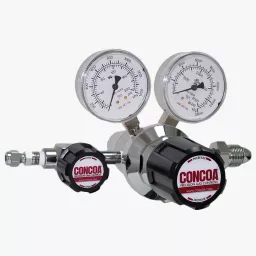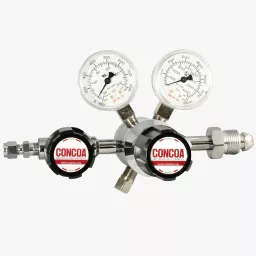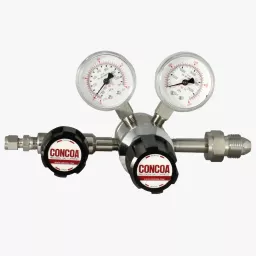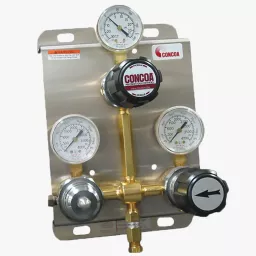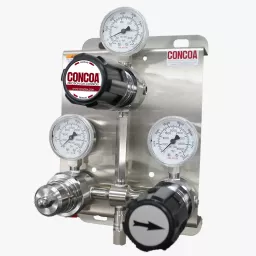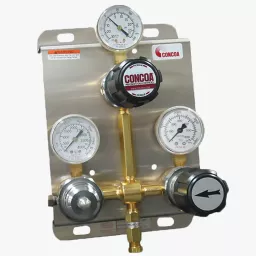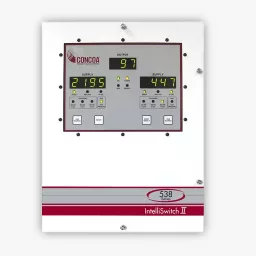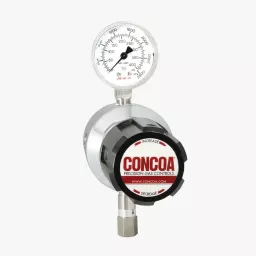A bioreactor is a vessel or tank that provides the controlled and specific environment required to grow cells and organisms. Bioreactors are used in various applications, including basic research and development and the manufacturing of biopharmaceuticals, food and food additives, biofuels, and other products.
For a reliable biological growth process, a constant supply of gases from high pressure gas or cryogenic liquid sources is required. Maintaining the gas supply at specific process conditions like pressure, temperature, and flow is essential to its function. For bioreactor operations, the four most commonly used gases are air, oxygen, nitrogen, and carbon dioxide. The accurate and reproducible dosing of these gases throughout the process cycle is essential to achieving optimum growth and controllable results. The growth phase of bacteria and cell cultures requires precise amounts of air or oxygen, typically with low concentrations of carbon dioxide, to sustain the metabolic processes. As growth progresses slowly, a culture needs less oxygen, and nitrogen may be injected to reduce levels to those resembling live in vivo states. Doses of pressurized air (21% oxygen and 79% nitrogen) or oxygen efficiently feed nutrients into the cell culture medium (liquid phase) as they are bubbled through the reactor during agitation stages. Later, oxygen and carbon dioxide drive the growth process, while carbon dioxide also regulates the acidity (pH) of the culture medium. Pure nitrogen is used to control the growth rate before harvesting. All of these gases must be maintained at a minimum purity level equal to or better than the United States Pharmacopeia - National Formulary (USP-NF) grades in order for the results and products to meet Current Good Manufacturing Practice regulations (cGMP) enforced by the Food and Drug Administration (FDA).
In order for the gas purity to be maintained at the levels of USP-NF and meet FDA cGMP requirements, the gas control system of pressure and flow regulation must be made of materials listed by the FDA as generally recognized as safe (GRAS) per FDA 21CFR177.1550. Nearly all CONCOA regulators, switchovers, and flow control systems comply with, and conform to GRAS and can be supplied with a GRAS Certificate. All of the following CONCOA regulators and systems conform to GRAS.
For benchtop bioreactors or smaller-scale operations using high pressure cylinders, the CONCOA 212 or 312 Series dual stage regulator provides constant pressure control and stable gas flow. Many users or facilities use purities considerably higher than the minimum USP-NF levels. For high-purity systems (up to grade 4.5) requiring better low-end pressure control or higher flow capacity, CONCOA recommends the 212 Series regulator, while the 312 or 332 Series regulator is suitable for ultra-high purity (up to grade 5.5) systems. Adding a 529 Series protocol station permits safe mounting or connection to multiple cylinders of the same gas. For increased bioreactor cycles requiring a continuous gas supply, the CONCOA 526 or 527 Series pressure differential switchover may be used. For automatic switchover from a cryogenic liquid cylinder primary with high-pressure reserves, the CONCOA 526 LC Series automatic switchover is recommended. CONCOA switchover systems are designed to interface with CONCOA remote alarms to provide audible and visual warnings when a switchover is about to occur.
For larger production bioreactors where gases are supplied from cryogenic liquid phase or bulk tanks, the CONCOA 538 Series IntelliSwitch II supports a liquid cylinder primary source with either high-pressure or liquid cylinder reserves. Electronic look-back and economizer features offer 97% primary cylinder utilization and 0% secondary cylinder vent loss. CONCOA 55 Series point-of-use panels with 400 Series regulators, such as the 484 or 486 Series regulators for high flows, offer final line pressure control and individual line isolation of carbon dioxide, oxygen, or nitrogen. If the cryogenic supply is stored inside, CONCOA strongly recommends a 580 Series oxygen deficiency monitor be installed in storage and usage areas, and any pipeline-relief valves should be piped to an appropriate exterior vent line as per safety code requirements.
Modern bioreactors have revolutionized the production of biological materials, from brewing beer to growing bacterial cultures to producing mammalian cells and pharmaceuticals. Bioreactors, vessels that provide a controlled environment for the growth and maintenance of biological organisms, have been used for thousands of years in various forms. The bioreactors that we know today use advanced technology to precisely control environmental conditions and optimize the production of biological materials. accurate, repeatable, and stable gas flows are essential.
For this, CONCOA recommends 312 Series dual stage regulators, 526CD Series, the 539 Series IntelliSwitch™ I, 538 Series IntelliSwitch™ II, which automatically switches to the reserve bank of cylinders once the primary side has been emptied, with virtually no temperature change. The IntelliSwitch II features proprietary onboard I-Link web server technology to allow remote monitoring and offers continuous gas pressure and flow control from liquid or high-pressure sources. If the liquid cylinder supply is bulk or sizeable, CONCOA recommends 580 Series Oxygen Deficiency Monitors be installed in storage or use areas and pipeline relief valves be piped to an appropriate exterior vent line.

